
Pairing Hyacinths
In the garden, in pots or in cut flower arrangements!
Contents
Awakening the garden in spring with their colourful flowerings, Hyacinths offer a wide variety of colours. Moreover, appearing from February to April, the Hyacinth flower diffuses a pleasant fragrance. This bulbous plant is a true olfactory and visual delight. For this reason, it is often forced to bloom earlier and scent the interior of the home during the festive season. Then, in spring, it makes a stunning impact in charming bouquets. Planted outdoors, it is perfect for creating a spring scene with other bulbs in a border, at the front of flower beds, or in front of spring-flowering bushes. Potted Hyacinths, near the house, on terraces or balconies, enchant us as the beautiful days arrive. Hyacinths can also be grown alongside perennials in a rockery, illuminating it with their colours. For all these possibilities, discover our ideas for successfully pairing Hyacinths!
In flowering pots
To fully enjoy the fragrance of Hyacinth flowers in spring, plant your bulbs in window boxes that you can place on a windowsill. No need to venture to the back of the garden in chilly weather to create fragrant bouquets for indoors! In a classic round pot, preferably terracotta, combine them with other bulbs such as Daffodils, Muscari, or Tulips. Plant them at different depths according to their size. For this, check out our illustrated tutorial on planting your spring bulbs in “lasagnes”. Another option: in a bowl, plant your Hyacinth bulbs alongside Forget-me-nots, Daisies, Garden Primroses, and Pansies, which are biennial plants also suitable for pot planting. Place your containers near your front door to create a welcoming entrance. Note that all varieties of Hyacinths can be planted in pots. A beautiful explosion of colours!
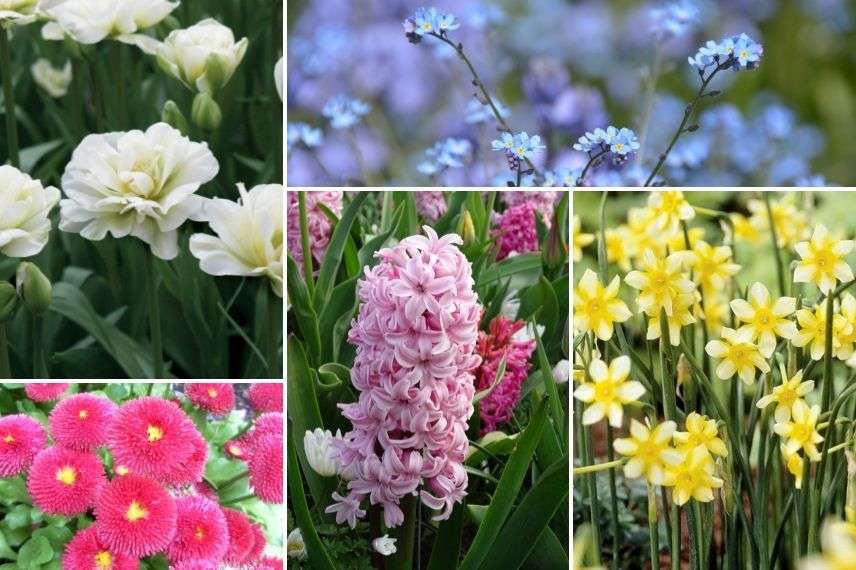
Tulip ‘White Touch’, Forget-me-not, Daisy ‘Tasso Rouge’, Hyacinth ‘Fondant’, and Daffodil ‘New Baby’
Read also
Hyacinth: planting, growing and careIn a border with other spring bulbs
Use Hyacinths to colour the edge of a path as spring arrives! Border planting should be dense. Group them by colour to create patches. Their fragrance is pure bliss for pathway users and garden visitors. Hyacinths pair very well with other spring bulbs that have similar growing conditions. Since planting occurs in autumn, it is very easy to combine them together. For example, create borders in bright tones by alternating different flowering bulbs: Spring Crocus, Dwarf Iris Iris reticulata, Florist’s Buttercup, the small Ornamental Garlic Allium oreophilum. The bell-shaped flowers of Snowdrops add a touch of brightness. Finally, Camassia and Fritillaries (for example, Fritillaria meleagris) bring rhythm to the border.

Snowdrop, Iris reticulata ‘Harmony’, Crocus ‘Pick Wick’ (photo jcwinkler), Hyacinth ‘Purple Sensation’ and Camassia cusickii
Discover other Hyacinths
View all →Available in 0 sizes
Available in 0 sizes
Available in 0 sizes
Available in 1 sizes
Available in 0 sizes
Available in 0 sizes
Available in 1 sizes
Available in 1 sizes
Available in 1 sizes
Available in 1 sizes
At the front of a border
In the foreground of a flowerbed, you can also plant Hyacinths with perennials. In the front row, install small creeping plants, such as Iberis sempervirens and Caucasian Rock Cress. From March onwards, Caucasian Doronicum ‘Little Leo’ brightens the garden with its simple yellow daisy-like flowers. Behind these perennials, Wilcott Spurge adds a luminous touch with its beautiful silver foliage. A bit taller, Bleeding Heart gives a romantic feel to the flowerbed with its heart-shaped flowers. To extend the flowering period, consider planting perennials that bloom from May onwards. For example, a pink variety of Moss Saxifrage (Saxifraga arendsii ‘Purpurteppich’ or Saxifraga arendsii ‘Peter Pan‘) can take over, as well as Campanulas, ground-cover plants that form beautiful colourful cushions. These will fill the space when the bulbs are in dormancy. Don’t forget the Alliums, which typically bloom between April and July. Varying in size, they add depth to the flowerbed. The tallest perennials should be placed in the background.
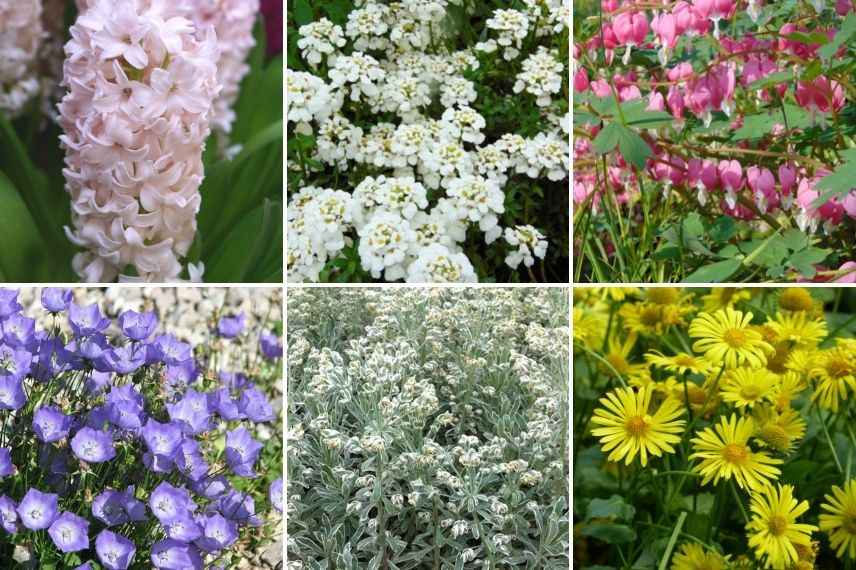
Hyacinth ‘China Pink’, Iberis sempervirens ‘Snowflake’, Bleeding Heart, Campanula carpatica (photo Wikipedia), Wilcott Spurge (photo Guido) and Caucasian Doronicum ‘Little Leo’
In rockery
Hyacinths can also be planted in rockeries. To accompany them, Sedums, whether creeping or upright, and Houseleeks are essential succulents for these locations: well-drained, stony, and poor soil, with sunny exposure. To add lightness, choose small grasses, such as Carex comans ‘Frosted Curls’, Carex buchananii, Carex testacea, and Stipa tenuifolia, also known as Angel’s Hair. Planted alongside succulents, their fine foliage creates a beautiful contrast. Then, choose floriferous perennials to add colour to the rockery. The Lithodora diffusa ‘Heavenly Blue’ carpets the rockery with star-shaped flowers of an intense gentian blue. As for the Mouse Ear, which is very floriferous, it easily covers spaces with its silvery grey foliage and numerous white flowers. The Pulsatilla ‘Papageno’ adds an original touch to the rockery with its fringed semi-double flowers and fluffy fruits.
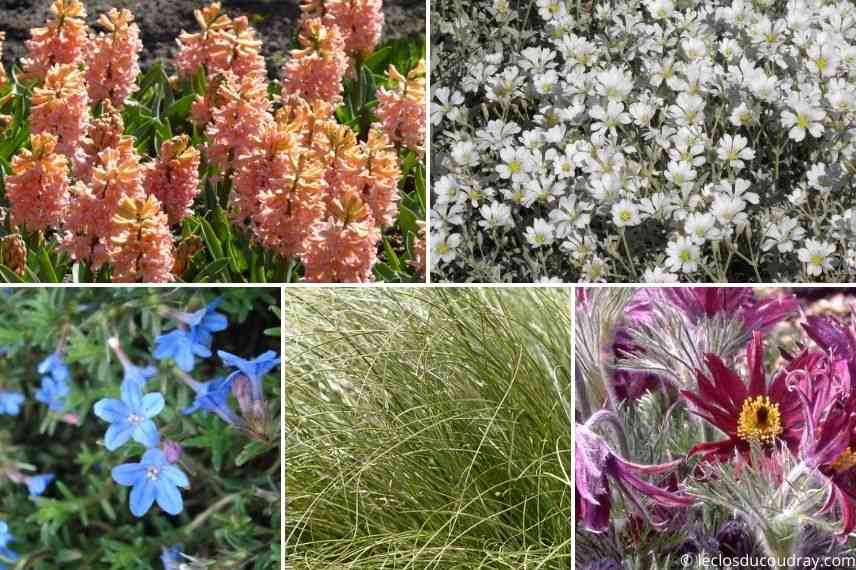
Hyacinth ‘Gipsy Queen’, Cerastium tomentosum ‘Yo Yo’ (photo Wikipedia), Lithodora diffusa ‘Heavenly Blue’, Carex comans ‘Frosted Curls’, and Pulsatilla ‘Papageno’
At the foot of deciduous bushes or trees
Use Hyacinths to flower the base of your trees or deciduous bushes, such as Cornel trees (Cornus mas, Cornus officinalis, etc.). Hyacinths, available in many shades, easily complement the wood of Cornus, which takes on beautiful orange-red or yellow hues in winter. Notable examples include the very decorative Cornus sanguinea, Cornus alba, or Cornus stolonifera ‘Flaviramea’. Without their leaves, they will allow sunlight to pass through in winter and early spring for good growth of the Hyacinths. The False Hazel (Corylopsis), which is adorned with bright yellow flowers very early in the year, can also be enhanced by a bed of Hyacinths. The flowering period of Hyacinths coincides with that of flowering cherries. You can find our selection of the 7 most beautiful flowering cherries in our advice sheet. You can also plant Hyacinths around spring-flowering bushes: Lilac, Forsythia, or spring-flowering Spiraea, such as Spiraea prunifolia or Spiraea thunbergii. Ensure that your bulbs are well exposed to sunlight or light partial shade. Too much shade would be detrimental to their flowering.
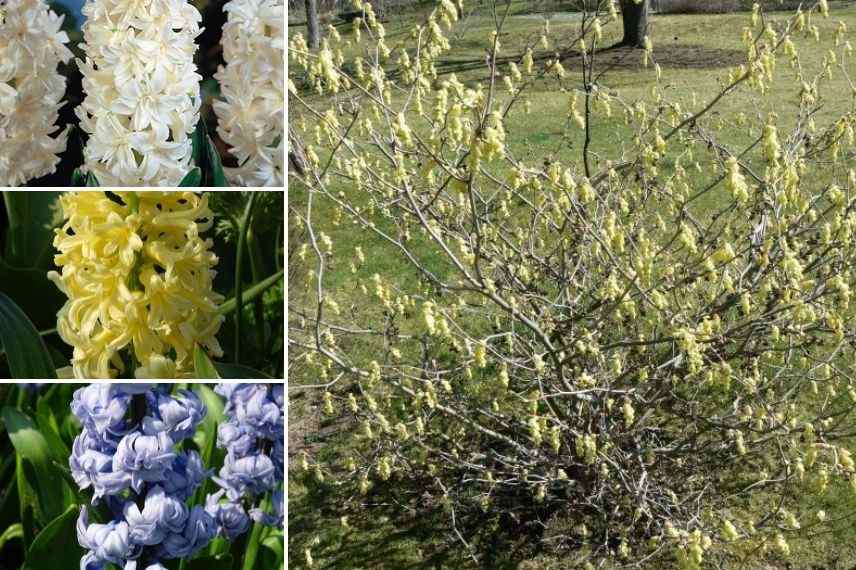
Dress the base of the False Hazel (Corylopsis willmottiae ‘Spring Purple’ – Photo Wikipedia) with Hyacinths of different colours. Here Hyacinthus orientalis ‘Madame Sophie’, ‘Gipsy Princess’, and ‘General Kohler’
In a cut flower arrangement with simplicity
With its wide range of colours, the Hyacinth easily integrates into floral arrangements. For Easter celebrations, yellow is often a prominent colour. Forsythia branches frequently feature in vase bouquet displays. These yellow flowers can be paired with Daffodils in white or yellow, varying in brightness. For a soft bouquet, mix pink with yellow and choose pink Hyacinths such as Hyacinthus orientalis ‘Fondant’ or Hyacinthus orientalis ‘China Pink’. Alternatively, pair yellow with a brighter colour like the blue of the Hyacinth ‘Blue Pearl’ or the slightly violet-blue flowers of the double Hyacinth ‘Crystal Palace’. The Tulip can also be paired with these fragrant flowers. Finally, add a few branches of Goat Willow bearing soft aments in winter.
Tip: to enjoy your Hyacinth bouquet for longer, choose flower stems with closed or barely open flowers. Keep the bulb. Using a knife, cut it vertically along the flower stem to create a four-sided bulb. Fill the vase with water without submerging the bulb.
Caution: the Hyacinth flower can be irritating to the skin, so we recommend handling it with gloves.
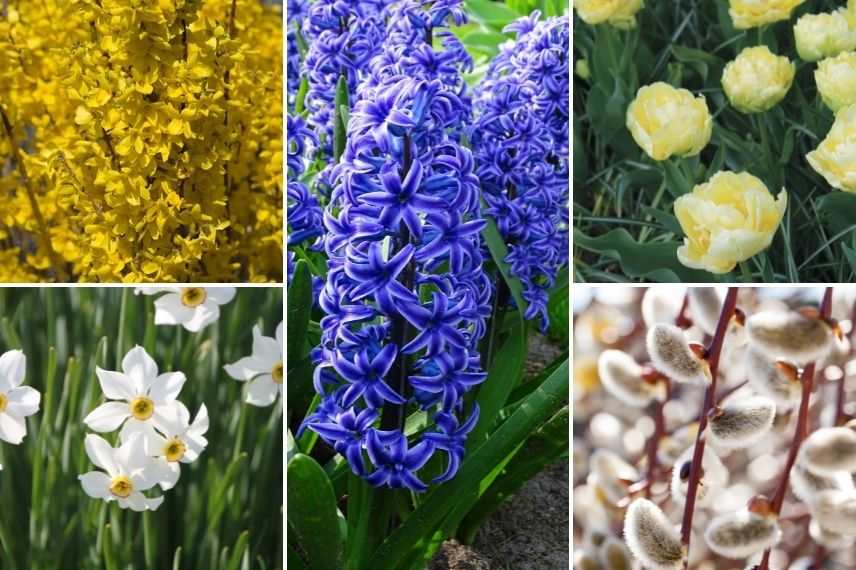
Forsythia intermedia ‘Weekend’, early double Tulip ‘Verona’, Narcissus poeticus ‘Recurvus’ (photo Pixabay), Hyacinth ‘Crystal Palace’ and Salix caprea
For further reading
- Discover our article to learn all about forcing Christmas hyacinths and how to force a hyacinth in a vase?
- Read our article: Planting hyacinths: our tips for planting them in the garden or in pots
- Subscribe!
- Contents
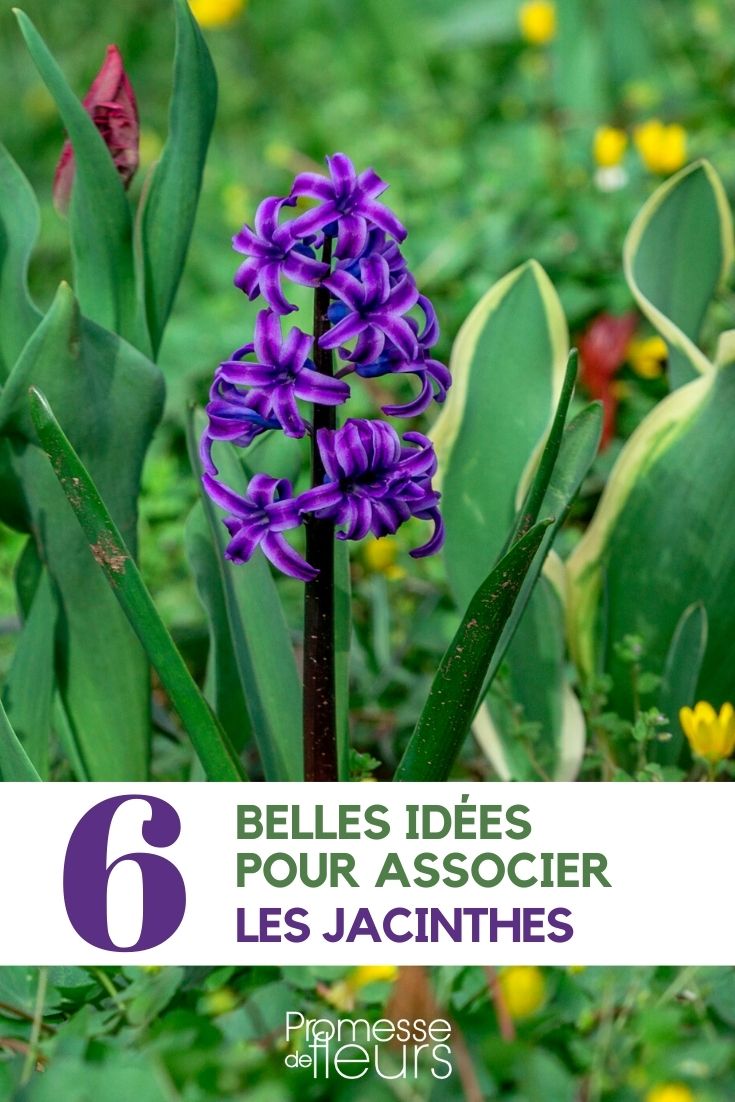


































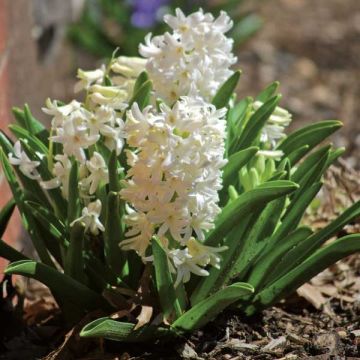
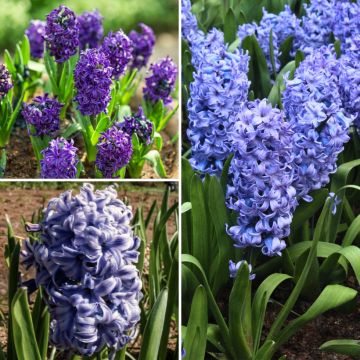

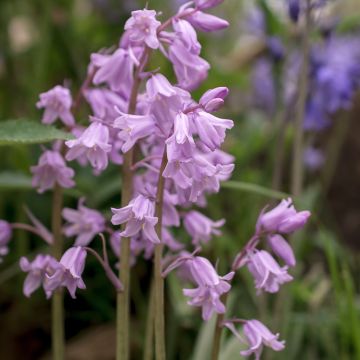


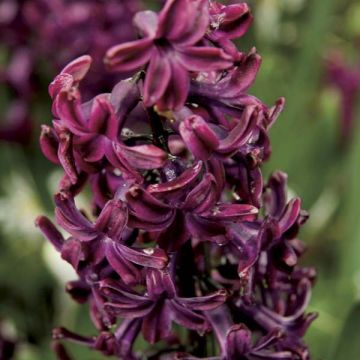
Comments